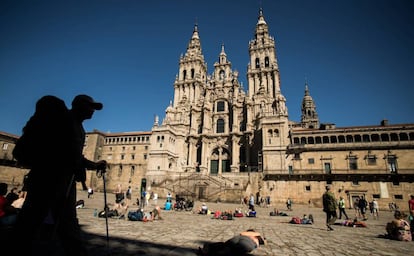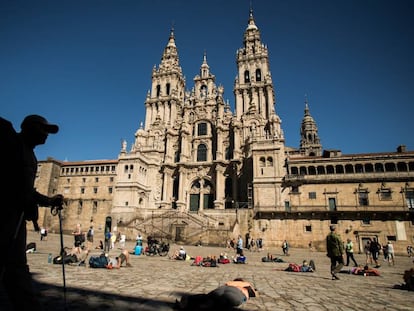Could Spanish cathedrals suffer the same fate as Notre-Dame?
Church leaders say safety measures are in place, but the budget for conservation has been cut dramatically in a decade

The devastating fire that ravaged Notre-Dame cathedral in Paris has set off alarms across Europe. Countries with ancient heritage sites of their own now wonder if existing contingency plans would be enough to protect them in the event of a similar situation.
Jos¨¦ Mar¨ªa P¨¦rez, an architect and EL PA?S cartoonist who works under the nom de plume Peridis, has spent several decades preserving and restoring Spain¡¯s Romanesque and Gothic architecture.
These are structures that hold up. Beyond the damage, Notre-Dame is still standing
Peridis, architect and cartoonist
The main thing is what experts call preventive conservation, he says. ¡°A cathedral, and any other temple, must be constantly subjected to maintenance work and diagnosis.¡±
Spain has made significant efforts in the last three decades to keep its 95 cathedrals in good condition, according to the Catholic Church, which owns them. But these buildings are very expensive to maintain, and a chronically small budget ¨C made even smaller by the economic crisis ¨C has been compounded by coordination problems.
The Culture Ministry has called a meeting of the Historical Heritage Council to support specific, up-to-date plans in all of Spain¡¯s regions. An accident like the one at Notre-Dame underscores the need to ¡°rethink and review¡± the situation even in cathedrals with existing plans, said Daniel Lorenzo, director of the Santiago Cathedral Foundation.

This newspaper has analyzed 13 of the most relevant cathedrals in Spain: Burgos, Santiago, Salamanca, Segovia, Oviedo, Barcelona, Palma de Mallorca, Valencia, Toledo, C¨®rdoba, Granada, Sevilla and Le¨®n.
In Valencia ¡°it is impossible to have a fire like Notre-Dame, because there is no wooden ceiling and over the vaults you have the terrace, just like in Seville and other Spanish cathedrals,¡± asserts Jaime Sancho, curator of the temple¡¯s artistic heritage.
Many Spanish cathedrals have been changing those wooden beams for metal or concrete ones, add the heads of the cathedrals in Burgos and Santiago. ¡°A fire like Paris would be unthinkable here in Toledo. Our vaults and roofings barely have any wood or other flammable elements,¡± says cathedral dean Juan Miguel Ferrer Grenesche.
Loss of conservation specialists
Ten years ago, Spain was earmarking €18.3 million for cathedral conservation. Today, that amount has dropped to €1.6 million.
"We cannot bear a 91% decrease in the conservation of cathedrals. The decline in investment for conservation is terrible." These are the words of Antonio Coronel, the president of the Spanish Association of Historical Heritage Restoration Companies (Arespa).
Earlier this week, Coronel and a dozen other specialists and politicians gathered in Madrid to discuss the need to preserve Spanish heritage. At the debate, entitled Heritage and Politics, Coronel underscored the consequences of the 2017 reform of the contracting law, which prioritized the more favorable economic bids for the restoration of historic monuments. "Who has benefited from the lack of specialization in contracts under €500,000 when we all know that the majority of restoration works cost less than that? I don't know, but the victims are the monuments, because we are seeing bad practices in restoration work, and irreparable damage is being done," says Colonel.
¡°This law is suffocating us. In any other country they are paying 20 times more for our work...We are going extinct because we do not have access to these contracts...The crafts are being lost, [our] heritage is in danger,¡± says Macarena Sanza Lucas, a restorer.
English version by Asia London Palomba.
But there is a risk at the cathedral-mosque of C¨®rdoba, with a surface area of 20,000 square meters and a ceiling made almost entirely of wood save for the Renaissance-era transept in the center. ¡°The most important thing for us is daily maintenance, something that is possible thanks to a team of nearly 100 people,¡± explains Gabriel Rebollo, one of the architects in charge of its conservation. ¡°There is a fire detection system with sensors scattered everywhere and connected to a central control room that is manned 24/7.¡±
At Santiago cathedral, which is undergoing a colossal restoration, new smoke detectors are going to be installed that will have to be compatible with the giant botafumeiro, an enormous incense-burner that is swung at great speed during Mass in a time-honored ceremony that has been witnessed by untold numbers of pilgrims on the Camino de Santiago.
Burgos cathedral has an Intergen gas system that goes off when it detects smoke or fire and absorbs the oxygen to stop the fire in its tracks, says Juan ?lvarez Quevedo, vice-president of the cathedral chapter. And in the wake of the Notre-Dame calamity, a team of firefighters is going to help draw up ¡°a kind of evacuation protocol¡± for its artworks.
In general terms, Spanish cathedrals have safety protocols, even during restoration work. But weak points remain: there are many flammable elements, mostly made of wood, inside the temples. One of the main concerns is the possibility of a short-circuit and the risks posed by electrical wiring.
And then there are case-specific concerns: in Oviedo, the cathedral is built on rock, and ¡°in many places the connection to ground is not as deep as it should,¡± notes Dean Benito Gallego, who is working on improving the lightning protection system.
And in Le¨®n, the weather seems to be the greatest enemy, judging by the last two incidents, which both took place in the winter: in 2007 two gargoyles fell off the building, and in 2015 a section of rain gutter broke off.
But as Peridis notes, ¡°these are structures that hold up. Beyond the damage, Notre-Dame is still standing.¡±
English version by Susana Urra.
Tu suscripci¨®n se est¨¢ usando en otro dispositivo
?Quieres a?adir otro usuario a tu suscripci¨®n?
Si contin¨²as leyendo en este dispositivo, no se podr¨¢ leer en el otro.
FlechaTu suscripci¨®n se est¨¢ usando en otro dispositivo y solo puedes acceder a EL PA?S desde un dispositivo a la vez.
Si quieres compartir tu cuenta, cambia tu suscripci¨®n a la modalidad Premium, as¨ª podr¨¢s a?adir otro usuario. Cada uno acceder¨¢ con su propia cuenta de email, lo que os permitir¨¢ personalizar vuestra experiencia en EL PA?S.
?Tienes una suscripci¨®n de empresa? Accede aqu¨ª para contratar m¨¢s cuentas.
En el caso de no saber qui¨¦n est¨¢ usando tu cuenta, te recomendamos cambiar tu contrase?a aqu¨ª.
Si decides continuar compartiendo tu cuenta, este mensaje se mostrar¨¢ en tu dispositivo y en el de la otra persona que est¨¢ usando tu cuenta de forma indefinida, afectando a tu experiencia de lectura. Puedes consultar aqu¨ª los t¨¦rminos y condiciones de la suscripci¨®n digital.










































